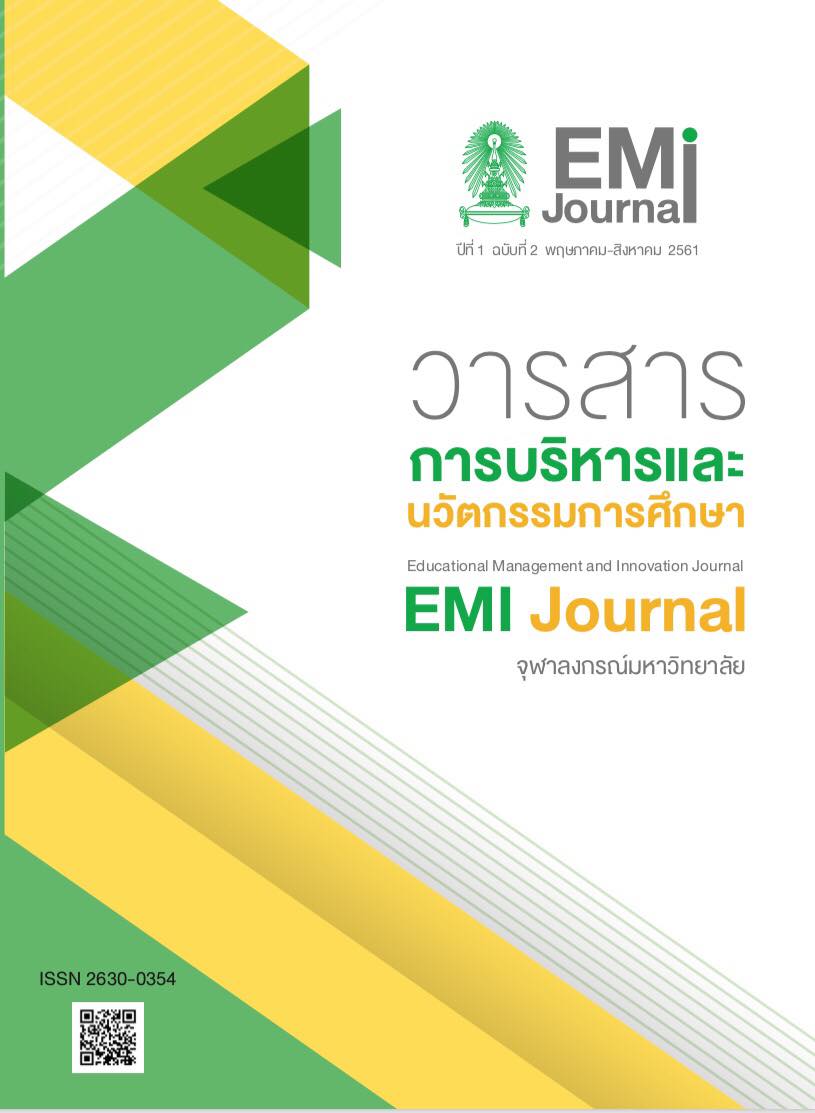ความหลากหลายทางชีวภาพกับการบริหารมหาวิทยาลัยกรณีศึกษา : มหาวิทยาลัยในยุโรป; THE UNIVERSITY MANAGEMENT THAT PROMOTES BIODIVERSITY BY LOOKING INTO A CASE STUDY UNIVERSITY IN EUROPE
คำสำคัญ:
ความหลากหลายทางชีวภาพ, การบริหารมหาวิทยาลัย, การเสริมสร้างความหลากหลายทางชีวภาพ, Biodiversity, University Management, Promoting biodiversityบทคัดย่อ
ความหลากหลายทางชีวภาพ มีความสำคัญต่อการดำรงชีวิตของมนุษย์ปัจจุบันจะพบว่าในแหล่งที่มีความหลากหลายทางชีวภาพที่สมบูรณ์แต่ผู้อาศัยในแหล่งนั้นกลับมีความยากจน การศึกษาครั้งนี้มีวัตถุประสงค์ เพื่อศึกษาการบริหารมหาวิทยาลัยที่เสริมสร้างความหลากหลายทางชีวภาพ ในกรณีศึกษา มหาวิทยาลัยในยุโรป เป็นการศึกษาเอกสารเกี่ยวกับกลยุทธ์ของมหาวิทยาลัยเกี่ยวกับความหลากหลายทางชีวภาพ ผลการศึกษาพบว่ามหาวิทยาลัยในสหราชอาณาจักรส่วนใหญ่ได้มีกำหนดกลยุทธ์ความหลากหลายทางชีวภาพเป็นภารกิจส่วนหนึ่งของการจัดการเรียนการสอน การจัดสภาพแวดล้อม การค้นคว้าวิจัย และการบริการให้กับท้องถิ่นที่เชื่อมโยงการแลกเปลี่ยนเรียนรู้ สร้างความตระหนักให้กับบุคลากรทั้งภายในและภายนอกมหาวิทยาลัยให้เห็นถึงความสำคัญต่อความหลากหลายทางชีวภาพ และในส่วนของปัจจัยที่จะเสริมสร้างความหลากหลายทางชีวภาพอย่างยั่งยืน ได้แก่ การเข้าถึงการแบ่งปันและการใช้ประโยชน์อย่างเท่าเทียม การอนุรักษ์และฟื้นฟู การพัฒนาคุณค่า และในการกำหนดกลยุทธ์ของแต่ละมหาวิทยาลัยจะสอดคล้องกับนโยบายของประเทศด้านความหลากหลายทางชีวภาพและตามสนธิสัญญาที่จัดทำขึ้นในการพัฒนาอย่างคุ้มค่าและการใช้ประโยชน์อย่างเท่าเทียมและยั่งยืนที่จะส่งผลดีต่อการดำรงชีวิตของมนุษย์ในโลกใบนี้
THE UNIVERSITY MANAGEMENT THAT PROMOTES BIODIVERSITY BY LOOKING INTO A CASE STUDY UNIVERSITY IN EUROPE
Biodiversity is vital to human living. It was found today that in those areas with rich biodiversity, their inhabitants however are in poverty. This study explored the university management that promotes biodiversity by looking into a case study of universities in Europe. Documentary study was employed to capture the university’s strategies on biodiversity. The findings revealed that most of those universities in the UK determined biodiversity strategies as part of their mission in the management of instruction, environment, research, and services offered to the locality in connection with knowledge exchange and learning, while raising awareness among staff within and outside of the university for their appreciation in the importance of biodiversity. Factors that promote sustained biodiversity included the access, sharing and equitable use, conservation and rehabilitation, and value development of biodiversity. Each university formulated biodiversity strategies in line with the national policy on biodiversity and the Convention on Biological Diversity with respect to worthily development, sustainable use and equitable sharing of the benefits for the advantages of human living in this world.
Downloads
เอกสารอ้างอิง
American Museum of Natural History. (2005). What is Biodiversity?. Retrieved May 18, 2015, from http://www.amnh.org/our-research/center-for-biodiversity-conservation/about/what-is-biodiversity
Butchart SH and others. (2010). Global Biodiversity: Indicator of Recent Declines. Retrieved May 12, 2015, from http://www.ebcc.info/wpimages/other/ Butchart_ Science2010.pdf
Carsten Rahbek. (2010). The biodiversity crisis: Worse than climate change. Retrieved May 1, 2015, from University of Copenhagen http://news.ku.dk/all news/2012/2012.1/biodiversity/
COHAB. (2010). Climate Change, Biodiversity, Conservation, Disease Burden and Environmental Management Emerging Iddues. Retrieved May 1, 2014, from http://ueab.ac.ke/BIRJ/download/birj_articles_2015/2015_CONFERENCE_14.pdf
Convention on Biological Diversity Belgian Clearing House. (2014). Convention on Biological Diversity. Retrieved April 23, 2015, from https://www.cbd.int/chm/network/
European Commission Environment. (2015). Global Diversity. Retrieved Jan 13, 2016, from http://ec.europa.eu/environment/nature/biodiversity/international/index_ en.htm
Gosselin et al. (2004). Biodisversity Values in internationsnl Laws and Conventions. Retrieved March 15, 2015, from www.set-revue.fr/sites/default/files/articles/pdf/article_02.pdf
ICSU. (2015). The International Council for Science and Climate Change: 60 years of facilitating climate change research and informing policy. Retrieved May 1, 2015, from International Council for Science http://www.icsu.org/publications/about-icsu/the-international-council-for-science-and-climate-change-2015/the-internationalcouncil-for-science-and-climate-change-2015
Loughborough University (2009). Retrieved May 12, 2015, from http://www.lboro.ac.uk/media/wwwlboroacuk/content/humanresources/downloads/EDAnnualStatisticalReport2011.pdf
Rebecca M. et al. (2014). Conservation Biology (CONSERV BIOL). Retrieved May 12, 2015, from https://www.researchgate.net/scientific.../35280952_Rebecca_M_Miller
University of Chicago. (2007). European cartographers and the Ottoman world, 1500-1750 [Video file]. Retrieved May 12, 2015, from http://www.youtube.com/watch?v=Xax5d4IKqrQ
University of the Arts London. (2013). University of the Arts London Biodiversity Action Plan 2013- 2016/17. Retrieved May 12, 2015, from http://www.arts.ac.uk/media/arts/about-ual/sustainability/Biodiversity-Framework-for-UAL-v3.pdf
University of Worcester. (2014). Biodiversity. Retrieved from https://www.worcester.ac.uk/researchportal/733.htm



